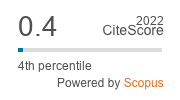Effect of change in mean monthly temperature and pH on the larvae of Aedes triseriatus Say, 1823 (Diptera: Culicidae) from North 24 Parganas of West Bengal
Keywords:
Aedes triseriatus, life cycle, larval count, mean monthly temperature, pHAbstract
Aedes triseriatus Say, 1823 commonly called the Eastern Tree Hole mosquito is the vector of La Crosse virus. Its larval density is highest in spring – early summer. Environmental parameters such as temperature and pH affect the life cycle of mosquitoes. Temperature affects every stage of the life cycle of Aedes sp. Effect of changes in the mean monthly temperature (MMT) and pH of the larval habitat on the larval count of A. triseriatus in North 24 Parganas district of West Bengal, India studies found that the larval count varied significantly with MMT (p value = 0.003) but not with pH (p value = 0.445). The maximal larval count was obtained in the temperature range of 27°C and 36°C with the highest at 33°C. The pH range of 6.65 to 7.05 supported a high larval count with the maximum count obtained at a pH of 7.05.Â


